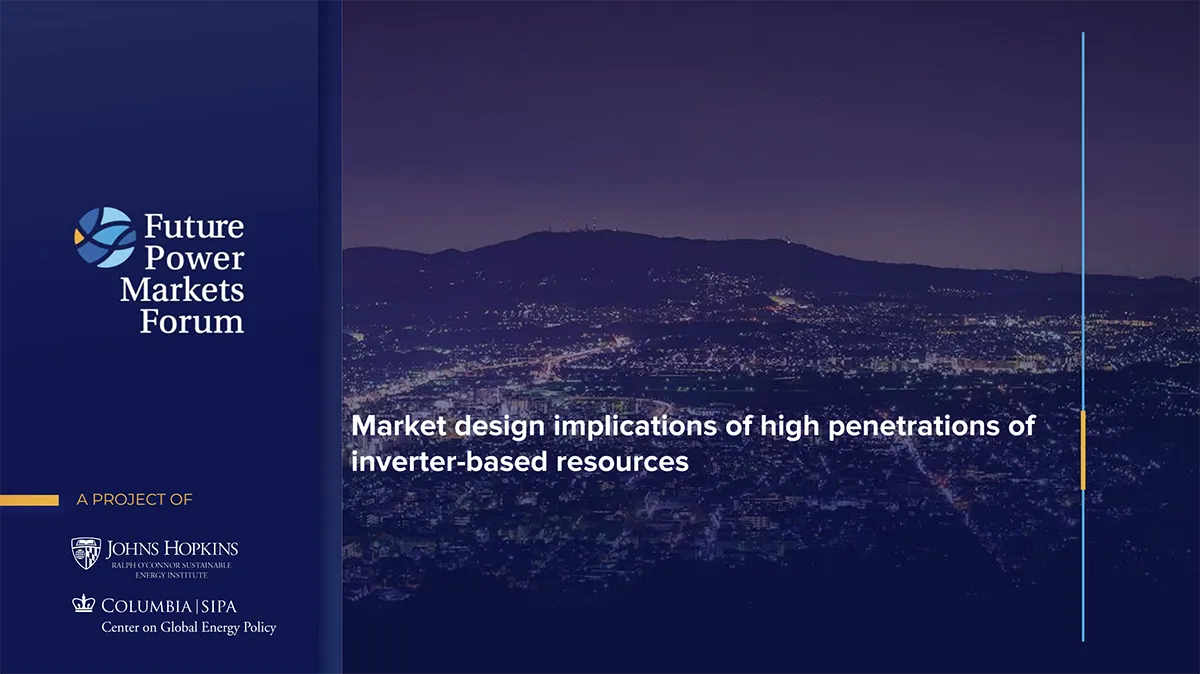Forum Topics
Decentralized Market Structures
Decentralized energy markets rely on active wholesale buyers to provide the certainty needed for new resources to be able to finance their investments at low costs. Unlike the centralized procurement of resources and services (see Topic 2), market participants contract directly with each other to negotiate the most efficient resource mix to balance their needs.
How could decentralized markets support the energy transition?
The featured publications and their accompanying slide decks, present the advantages and risks of this approach to energy markets as well as guidelines for implementation.
Market design implications of high penetrations of inverter-based resources
The presentation examines the operational and control challenges introduced by a high share of inverter-based resources (IBRs) such as wind, solar, and batteries in the power system. It outlines the differences between grid-following and grid-forming inverters, emphasizing the need for new market designs and services to ensure system stability and reliability. The presentation also discusses strategies for integrating these resources into the grid, highlighting examples from various system operators and suggesting market adaptations to accommodate the unique characteristics of IBRs.
Relevant Publications
In My View: Market Design Practices: Which Ones Are Best?
William W. Hogan
January 2019
Wholesale Electricity Market Design for Rapid Decarbonization: a Decentralized Markets Approach
By Rob Gramlich and Michael Hogan
June 2019
Expert Commentary
These comments are personal opinions and do not represent the official position of an expert’s employer or clients or the Future Power Markets Forum.
Elise Caplan, American Public Power Association
APPA agrees that the RTO-operated energy markets are well suited to dispatch existing resources efficiently and reduce production costs, but does not support major changes to these markets – especially increases in scarcity pricing which can adversely impact consumers and increase market power without necessarily achieving reliability or other benefits. Short-term energy markets are generally not well suited to drive long-term capital-intensive investment decisions, which should be recognized in market design choices.
Mark Dyson, Rocky Mountain Institute
The ERCOT experience has been promising to date, but it’s not yet clear what (if any) changes are needed to support a transition to a deeply decarbonized power system. Questions remain around several issues, including the timing of economically-efficient and climate-aligned resource exit in the near term, and the limits of uncoordinated resource entry as the operating definition of “resource adequacy” evolves in the course of system decarbonization.
Devin Hartman, R Street Institute
Decision making with imperfect information has been a dominant theme in electricity regulation. It’s easy to become overconfident that ever-sophisticated modeling can determine the optimal resource portfolio, but this ex ante illusion merely plays into a central planning bias with a notorious track record. We will always have a knowledge problem; in fact the information gap between regulators and utilities has never been greater. Thus, there’s no question that markets allocate resources, promote innovation and manage risk better than centrally planned resources with socialized cost recovery (i.e., IRP model). The question is whether markets should have a lighter-touch “visible hand” of market design (i.e., decentralized market model) or play a greater role in defining resource needs (i.e., centralized market model).
The evolving characteristics of the industry – especially massive heterogeneity in supply resources and the ability for consumers to exercise their diverse preferences – suggest the decentralized model is the first-best solution. But the model will only flourish if certain conditions are satisfied, including manageable transactions costs and information asymmetries. The ability to make electricity fungible enough in real time with storage and price-responsive demand may well provide the ultimate test.
Travis Kavulla, NRG Energy
Everyone seems to agree that an abundance of renewables, in demand by consumers and government alike, will have significant consequences on the archetypical electricity market—a market that reflects the real-time value of supply which, putting additions to it aside, very few seriously question. These new challenges are caused by the fact that an abundant supply of zero- or negative-marginal-cost resources will drive prices frequently to zero while, at other times, their intermittency causes those prices to skyrocket. The responses to this phenomenon all too often begin with how to reform a market that gets the “right” supply: ensuring supply resources are paid enough money, are diversified or “innovative,” and are driving consistently toward decarbonization. But if changes in supply are driving the markets’ new dynamism in the first instance, should not the more immediate takeaway be what are buyers doing to take advantage of the new supply?
The upshot is that too little consideration is given to the incentives of customers and firms that act on behalf of customers in buying and serving them electricity. U.S. regulation does not uniformly face such firms with financial consequences around the economic efficiency of their supply of load—or at least we don’t in the many markets that are attended to by dominant utility monopolies and default entities for whom this inefficiency either is a wash or even profitable because of the perverse incentives latent in utility regulation. The conversation about wholesale market design and the evolving supply mix actually needs at its core a discussion of how a market can reform and replace these firms, thereby turning its load-serving entities into actors responsible for shaping, rationalizing, and absorbing the markets’ new dynamism through both its service to demand and its supply procurements. This conversation begins in considering whether and how competition between these retailers is working, especially an understanding of why it seems only to be especially working well in one U.S. market, namely ERCOT.
Joshua Macey, University of Chicago
There is a great deal of agreement about market design, and especially about the need for real-time energy markets to account for a significant percentage of generator revenue—regardless of whether one prefers a centralized or a decentralized model. The conversations have often focused on first-best solutions. It is clear that energy-only markets are highly efficient, and that any good market design requires energy markets to send strong price signals. It is critical, however, to consider second-best solutions that would accommodate states that lack the political will to implement an energy-only market. We also need to think about how to deal with market power issues when renewables make up a greater share of the resource mix. Presumably, larger volumes of renewables will increase volatility. Moreover, intermittency increases the need for firm supply. It would be useful for us to think about how to mitigate market power abuses without diluting incentives for generators to provide value in real time.
Jacob Mays, Cornell University
It is my belief that organized wholesale markets should produce full-strength prices for energy and ancillary services, i.e., prices high enough to provide sufficient revenue for an efficient capacity mix. Full-strength prices allow a more accurate assessment of the value resources provide to the system and serve as the best possible basis for investment and operational decisions. The volatility inherent to such markets, however, presents a challenge for risk management, especially in regions without well-developed retail competition. Accordingly, there could be good arguments for centralized markets that facilitate risk sharing around these prices.
While effective scarcity pricing draws the bulk of the attention, it is worth mentioning the need for more research and debate regarding the second proposed reform described in Professor Hogan’s article. Implementing multi-period, preferably stochastic models for dispatch and pricing could improve operational and market efficiency. The logic of extended locational marginal pricing, however, deserves further scrutiny in this context. In particular, some attempts to account for avoidable fixed costs in price formation could lead to socialization of losses, double payment for generators, and poor incentives for flexibility. These possibilities become even more likely with effective scarcity pricing in place. Accordingly, some care is needed to ensure that implemented price formation schemes actually accomplish the stated goal of supporting efficient commitment and dispatch.
Rana Mukerji, New York Independent System Operator
My belief is that current wholesale market structures are fundamentally sound but were not designed to consider environmental externalities. Carbon Pricing is the most efficient mechanism to integrate the environmental externalities with the current wholesale market design. In addition to carbon pricing enhanced Operating Reserve Demand Curves are needed to provide strong incentives for resources and demand to respond to changing real time system conditions.
The New York Carbon Pricing studies have shown Carbon Price together with a well-functioning energy and capacity market is very effective in reconciling State’s Public Policy Goals within a wholesale market. Such a mechanism allows Renewable Energy Credits (RECs) to co-exist within a Carbon Pricing mechanism allowing State Policy Makers sufficient leverage to attain particular policy goals without unduly encumbering the wholesale market. Moreover given a Carbon Price, the need for and magnitude of RECs diminish significantly, leading to better market efficiencies and increased Carbon Reduction. Locational signals are also enhanced incenting renewable resources to locate in the most favorable areas. Prof. William Hogan of Harvard and others have well documented the efficacy of enhanced Operating Reserve Demand Curve (ORDC) based scarcity pricing as adopted by ERCOT and also being aggressively pursued by the Eastern ISO/RTOs. Enhanced ORDC based scarcity prices would be beneficial in terms of infra-marginal revenues to supply some of the “missing money” as well as give better locational and real time performance incentives.
Andrew Ott, Formerly PJM Interconnection
Regarding the ERCOT market. I think it is possible to sustain investment and long term contracting in a market with pure retail competition meaning there is no regulated utility affiliated generation, no state administered backstop or price limit and some guarantee that the state would not intervene in a supply shortage. That said my experience is this could only work in a single state wholesale market.
For markets with multiple states (like ISONE, PJM, etc.) it seems to me an energy only market is much more difficult because of the potential cost shifts related to differences in reserve margins and getting agreement between all the states within the market to allow pure retail competition with no interference.
Power Market Structure & Design
If you have something you would like to contribute to the topic you can include your comment here.


